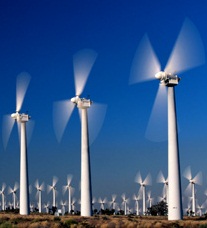San Diego activists want solar built in urban areas, not rural
 San Diego County activists are speaking out against San Diego Gas & Electric’s (SDG&E’s) plans to install a large wind farm in the eastern part of the county and the Sunrise Powerlink transmission lines that would carry the power to urban areas. They allege that urban solar installations could equal the power produced by the proposed farm without using undeveloped land.
San Diego County activists are speaking out against San Diego Gas & Electric’s (SDG&E’s) plans to install a large wind farm in the eastern part of the county and the Sunrise Powerlink transmission lines that would carry the power to urban areas. They allege that urban solar installations could equal the power produced by the proposed farm without using undeveloped land.
In separate opinion pieces that appeared in the San Diego Union-Tribune on Sunday opposing sides on the development of large-scale renewable energy projects spoke out.
On one side, the American Indian people of the Campo Kumeyaay Nation argued for the development of a 160-megawatt wind farm on their land. The nation is working to develop the wind farm with SDG&E and said it will bring jobs to the American Indian nation and to eastern San Diego County.
On the other side, Donna Tisdale, president of Backcountry Against Dumps, chair of Boulevard Planning Group and secretary of The Protect Our Communities Foundation said the proposed wind farm and the transmission lines were unnecessary and would affect the local community of Boulevard, Calif.
“We are the targeted area, with about 392 turbines proposed at the farm,” she said. The wind farm would be within a small geographic area. She added that the farm would be built on land set aside for resource conservation, recreation and more.
In the opinion piece, Tisdale and coauthor Bill Powers wrote, “The solar potential on rooftops and parking lots in San Diego County is vast and can provide most renewable energy needed to eliminate our fossil-fuel dependence. Rooftop solar was once too expensive, and SDG&E and parent Sempra Energy still fight it to protect their centralized, fossil-fueled business model. But rooftop solar can now compete effectively in price with any form of renewable energy, including wind.”
She said that Powers’ report “San Diego Smart Energy 2020,” outlined a way for the county to install more than 2 gigawatts of photovoltaics on urban structures to meet the needs of the region, rather than install rural large-scale renewable developments and the Sunrise Powerlink.
According to Tisdale, Sempra Energy will make more money off of infrastructure development than by developing distributed sources of solar in San Diego. For instance, by developing the Sunrise Powerlink transmission line and carrying electricity into San Diego, the company is assured profits through the transmission of electricity.
“They get a guaranteed profit on it all,” Tisdale said.
At this point, Tisdale said the groups are pursuing numerous legal actions against SDG&E. Among them, a coalition of nonprofits have filed state and federal lawsuits against the Sunrise Powerlink.
Neither SDG&E nor the Campo Kumeyaay Nation responded to requests for comment by press time.
Image courtesy of Sempra Energy.



